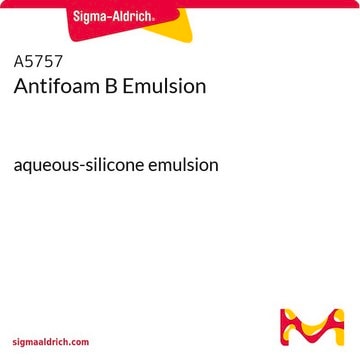A8678
Agar
suitable for plant cell culture
Synonim(y):
Agar-agar, Gum agar
About This Item
Polecane produkty
pochodzenie biologiczne
algae (Rhodophyceae)
Postać
powder
metody
cell culture | plant: suitable
mp
80-90 °C (1.5% in water)
temp. przejścia
transition temp 27-37 °C (1.5%)
Zastosowanie
agriculture
temp. przechowywania
room temp
InChI
1S/C14H24O9/c1-5-8(16)13-11(7(21-5)4-20-13)23-14-10(18)12(19-2)9(17)6(3-15)22-14/h5-18H,3-4H2,1-2H3/t5?,6-,7?,8-,9+,10-,11?,12+,13+,14?/m1/s1
Klucz InChI
GYYDPBCUIJTIBM-DYOGSRDZSA-N
Szukasz podobnych produktów? Odwiedź Przewodnik dotyczący porównywania produktów
Powiązane kategorie
Opis ogólny
Zastosowanie
- as a supplement (0.9% w/v) to Murashige and Skoog basal medium for plant growth
- in the preparation of cocultivation medium for Agrobacterium tumefaciens mediated transformation in maize (Zea mays) hybrid Hi-II
- as a component in the complete medium to regenerate protoplasts of Piriformospora indica
- as a clean agar medium to culture Synechococcus WH7803 strain
Działania biochem./fizjol.
Uwaga dotycząca przygotowania
Kod klasy składowania
11 - Combustible Solids
Klasa zagrożenia wodnego (WGK)
WGK 1
Środki ochrony indywidualnej
Eyeshields, Gloves, type N95 (US)
Certyfikaty analizy (CoA)
Poszukaj Certyfikaty analizy (CoA), wpisując numer partii/serii produktów. Numery serii i partii można znaleźć na etykiecie produktu po słowach „seria” lub „partia”.
Masz już ten produkt?
Dokumenty związane z niedawno zakupionymi produktami zostały zamieszczone w Bibliotece dokumentów.
Klienci oglądali również te produkty
Nasz zespół naukowców ma doświadczenie we wszystkich obszarach badań, w tym w naukach przyrodniczych, materiałoznawstwie, syntezie chemicznej, chromatografii, analityce i wielu innych dziedzinach.
Skontaktuj się z zespołem ds. pomocy technicznej








